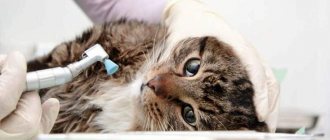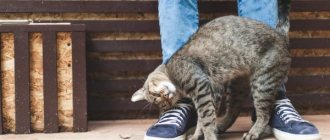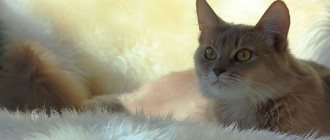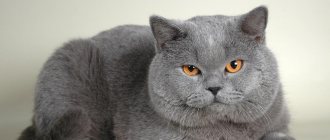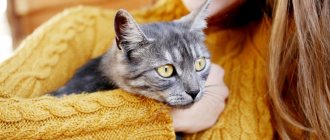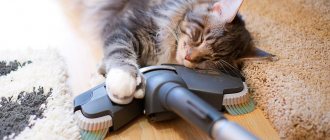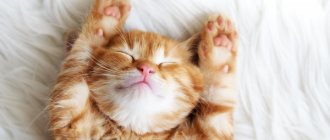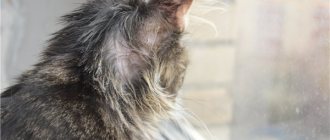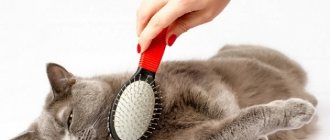For every cat owner, a source of pride is its shiny and beautiful coat. As soon as the cat begins to actively lose its fur, spreading its fur throughout the apartment, especially when the cat's shedding is prolonged, the owners begin to worry. And the cause of concern is not only frequent wet cleaning in the apartment due to the large amount of cat hair, but also whether your pet is sick.
Is shedding normal in a cat or is it one of the symptoms of some disease?
Seasonal shedding. Molting is inherent in all living beings. A cat living in a city apartment is no exception. In the spring, cats change their “coat” in accordance with the growing warmth in nature, and in the fall, with the approach of cold weather, that is, the cat’s owners observe the process of losing and growing new hair. During shedding, the cat behaves as usual, its appetite is preserved, and it does not outwardly look sick. When a cat sheds, it leaves behind a large amount of fur. To keep your pet's coat smooth and fluffy during shedding, try to choose the highest quality premium food. Brush your cat regularly using special brushes and combs. In cats living in city apartments, shedding can last from 2 to 3 months.
Apartment molt . Cats living in an apartment shed all year round, despite good nutrition, absolute health and quality care. Such cats practically do not feel the change of seasons: the molting period in indoor cats stretches for several months, or even the whole year. Indoor shedding intensifies in winter, when the heating starts working in the house or apartment, and the drier the air in the room, the stronger the cat’s shedding. Air conditioners, air humidifiers, and even simple aquariums can partially help owners cope with indoor shedding. For such a cat, owners need to choose suitable food and professional hygiene products (shampoo, conditioner, nourishing masks). Anti-shedding vitamins for cats are effective, but they should not be abused - a maximum of two monthly courses per year.
Baby shedding is the process of changing a kitten's fur to adult fur. Kittens begin to shed at 6 months of age. Molting in kittens continues for 1-2 months. Coarser adult hair grows back, which is thicker and heavier than baby fur. At the same time, the patterned kittens become brighter - the ghostly haze disappears, and the slight fading of the fur, necessary for camouflaging the young, disappears. The dark areas of the skin of Siamese and Burmese become brighter and richer. During a child's coat change, no remedy for shedding cats will help; the owner can only comb the coat daily and make sure that the baby is fed well. The better the living conditions, the faster the coat will change and the more beautiful the adult coat will be.
Pregnancy and feeding kittens . Loss of a significant amount of hair, up to partial baldness, can also be noted in pregnant cats because... During pregnancy, a profound restructuring of metabolism occurs in a cat’s body, and the cat primarily spends the nutrients supplied with food on building the body of the kittens and on their subsequent feeding. After a cat stops feeding her offspring, her coat returns to normal and looks like before pregnancy.
Old age of the cat. Owners often notice thinning fur in older cats around the ears and face. This hair loss does not require special drug treatment; you will need to consult a specialist about feeding an aging cat.
Stressful situations - all animals, including cats, can worry and experience severe nervous overexcitation, which ultimately negatively affects their health, as well as the quality of their coat. A trip to the country, a change of place of residence, the arrival of a new tenant, a fight with its relatives during a walk, meeting a dog, quarrels between family members can become reasons for a cat’s distress. If your pet sheds because of this, then it is important to create a calm atmosphere, surround it with attention and care, and provide sedatives.
Improper grooming is often the reason why a cat sheds all year round. In the case when the cat is clinically healthy, and the change in coat is not pronounced - it sheds little by little and all year round, it is necessary to pay attention to the composition of shampoos, the quality of brushes and other grooming tools. Owners should brush their cat at least once a week: gentle movements with the brush stimulate blood circulation, improving nutrition of the hair follicles and reducing shedding. Shampoos and conditioners must be chosen specifically for cats, and do not forget to dilute them as written on the packaging.
Seasonal molting and its timing
Seasonal molting occurs twice a year: from February to March, the cat gradually prepares for summer, getting rid of winter fur, and from September to October, on the contrary, it strives to make room for a warm winter coat. The timing of shedding may vary depending on the breed of the cat, its climate zone, and the pet’s living conditions, but on average it lasts 2–3 weeks.
During shedding, a cat's behavior may change somewhat: it becomes less active, licks itself frequently, and some pets become irritable. But the general condition should not suffer: the nose should be cold, the eyes should be clean, the food should be eaten, and the tray should be visited as scheduled.
During normal shedding, the amount of fur a cat sheds increases, but does not become excessive . The replacement occurs evenly, without the formation of areas of focal alopecia (baldness).
During shedding, the cat often licks itself to remove dead hairs.
Kittens' first molt
Kittens have their first moult
is accompanied by the replacement of undyed hairs with the hair of adult animals and occurs
this is most often
at the age of 5-7 months, in spring or autumn
. When purchasing kittens, you should understand that their color will likely change. Shedding starts from the head and gradually continues throughout the kitten's body. The animal's head will receive its permanent color before other parts of the body, and the rest of the body can molt for a whole year or even more.
Features of shedding of some breeds
How a cat sheds is largely determined by its breed. The amount of hair left behind by a shedding cat is affected not only by the length of its coat (guard hair), but also by the density and length of the undercoat.
If we consider cat breeds according to the intensity of shedding, they can be divided into:
- highly shedding cats with a lot of undercoat: Persian and Himalayan cats;
- Maine Coon;
- British cat;
- Angora cat;
- Siamese cat;
- sphinxes - depending on the variety, hair may be completely absent or its length may be no more than 2 mm;
Shedding in sphinxes is minimal due to the almost complete absence of hair.
Hair loss is a serious symptom
Seasonal shedding in cats lasts from two to three weeks to one and a half months; the age-related change of coat in kittens can last for six months. In theory, anything outside these parameters should be considered an abnormality. But there is a nuance: as we said, after moving into houses, our smaller brothers can shed all year round, while remaining completely healthy.
Domestic cats can shed all year round
Yet hair loss in animals is often a symptom of a disease or other health disorder, and domestic cats are no exception. Thus, a paradoxical situation arises: the same external manifestations can be either a kind of “payment for shelter” or an alarm bell. In one case, nothing needs to be done, moreover, an attempt to treat the animal can cause harm to it, and in the other, the pet, on the contrary, needs qualified help. The problem is so difficult that even an experienced veterinarian is not always able to solve it. But a responsible animal owner simply must do this. So the cat is shedding. Most likely, everything is fine with her if:
- the skin visible between the hairs retains a natural and uniform color;
- the fur does not fall out in clumps, leaving bare areas of skin (bald spots can appear behind the ears, above the eyes, on the stomach, thighs, and the inner surface of the paws);
- the pet’s behavior has not changed, the cat looks healthy, eats well, digestion is not upset;
- urine and feces have normal color and odor;
- the animal's nose is moist, its eyes are shiny;
- there is no frankly unpleasant odor from the mouth;
- Body temperature, if you can measure it, is normal (in cats it is between 38.0 and 39.0).
In a word, you need to understand a simple thing. Hair loss is almost never the only symptom of a particular disease: as a rule, there are other signs. Finding them or making sure that they are absent is the main task of the owner. Let's look at some of the most common causes of pathological hair loss in cats.
Hormonal disbalance
When experts strongly recommend sterilizing domestic animals of both sexes (with the exception of those specifically used for breeding), they know what they are talking about.
It has been observed that sterilized cats live an average of 15–20 years. For comparison, the average lifespan of a domestic cat is 10–12 years; outdoor cats rarely live past 5 years of age. And if the difference between a pet and an animal forced to fight for survival can be explained by the quality of life (in civilized countries people also live longer than in backward ones), then the obvious advantage of sterilized animals over their no less “caressed” brothers is explained by only one thing - the absence hormonal shocks.
In favor of sterilization, it should also be said that cats, like the vast majority of animals, do not have such a thing as orgasm. Mating and childbearing, contrary to the opinion of some “humanists,” are not beneficial to the cat’s health; this is just a natural need to preserve the species, which in the case of pets is perfectly solved through targeted breeding.
If you do not agree with the position accepted as the basis throughout the civilized world, at least take the trouble to ensure your animal’s full realization of sexual instincts, but under no circumstances do you stuff it with hormonal drugs that suppress sexual desire, and do not endure heart-rending screams while clenching your teeth unfortunate beast.
This is inhumane and very dangerous for the cat’s health.
Estrus causes a lot of inconvenience for a cat and its owner.
Severe hair loss is often caused by hormonal imbalance, and the latter, in turn, is inevitable when taking various “anti-sex medications.” The same reason, by the way, explains the increased shedding in cats after estrus, during pregnancy and after childbirth: hormones go crazy - just like in humans.
Stress
We come to another problem that can cause hair loss. This is an emotional shock.
Usually a cat knows how to stand up for itself
But there are factors to which even these proud and independent creatures react very painfully. These include, in particular:
- moving (the well-known formula that a dog is attached to its owner, and a cat is attached to the house, is only partly true, but there is certainly some truth in it);
- transportation, especially in tight carrying;
- painful medical procedures associated with anesthesia, fixation (tying up) and other violations of “personal integrity”;
- the appearance of another animal in the house, especially if it is perceived as a source of danger or a “competitor”;
- loneliness, especially if for the first time the animal is left alone in an empty room for a long period of time;
- a sharp change in attitude towards oneself on the part of the owner;
- the introduction of new rules and restrictions that did not exist before (for example, a cat got used to sleeping with its owner, and at some point they stopped allowing it to do so).
The cause of hair loss may be longing for its owner.
In a word, if a cat begins to lose a large amount of hair, think about whether something happened that provoked strong feelings in the animal.
Allergy
Allergies in cats are usually accompanied not just by hair loss, but by the formation of bald patches (so-called alopecia).
But the opposite rule does not work: allergies are not the most likely cause of baldness in individual areas of the skin, and their localization in this case will not clarify anything.
One of the causes of receding hairline is allergies.
The only correct course of action is to analyze whether there have been any changes in the diet, and if there have been, exclude the probable allergen, and then continue observation.
Poor nutrition and dysbiosis
A cat's diet must be balanced; food from our table cannot replace it.
High-quality cat food contains everything necessary for the health of the animal. Adherents of natural food need to put in a lot more effort to make their pet's coat shiny and glossy.
Sometimes the cause of hair loss is dysbiosis, which is not caused by nutritional problems, but, for example, by recent antibiotic treatment. In this case, shedding is usually accompanied by other characteristic symptoms, primarily intestinal dysfunction.
Old age
As we age, various diseases appear and worsen, and the body begins to work like a poorly regulated machine. The same thing happens with cats.
In an older animal, the fur coat loses its thickness and silkiness, becomes tangled and falls out, sometimes forming quite distinct bald spots.
This is a natural and, unfortunately, irreversible process.
In old age, the animal’s fur no longer looks thick and silky.
Diseases in cats
Increased hair loss can be a sign of a disease, either skin, caused by parasites or fungal infections, or internal. The first category of diseases includes:
- ringworm (fungal infection, pathogens - dermatophytes);
- demodicosis (caused by subcutaneous mites);
- dermatitis (can be caused by bacteria, fungi and even flea bites);
- scabies (caused by the Notoedris cati mite);
- eczema (can be caused by various reasons).
All these diseases have a very clear clinical picture, the lesions are clearly visible, and if you consult a specialist in a timely manner, diagnosis and treatment do not cause problems.
Ringworm is an infectious skin disease of a fungal nature.
The situation is more complicated with systemic internal diseases, which at a certain stage begin to acquire external manifestations, affecting, in particular, the quality of wool. In fact, this symptom can be caused by literally anything: from endocrine system disorders, including diabetes, to neoplasms.
In such cases, hair loss is a secondary symptom; therefore, there is no point in fighting it: you need to look for the cause of the disease and treat it.
Possible causes of heavy shedding
The reasons why shedding ceases to be seasonal and its period becomes longer in healthy cats may be:
- Keeping a cat in an apartment, especially when it does not have access to the street. The cat continues to shed throughout the year as it loses its seasonal biorhythms. This is due to the fact that the temperature of the apartment does not have seasonal fluctuations, and in winter, with the central heating turned on and the air humidity decreasing, the cat’s shedding even intensifies, despite the fact that the animal is completely healthy and has good nutrition and good care.
- Baby shedding. In six-month-old kittens, soft baby fur is replaced with coarser adult fur, which is thicker, tougher and brighter. At the same time, the patterns on the fur become more contrasting, the existing “points” become bright, and the dullness and softness of the fur characteristic of kittens disappears. Baby shedding lasts 1–2 months and marks the beginning of hormonal maturation. The complete structure of the coat will complete its formation only by 2.5–3 years, and the cat will have well-defined guard hair, undercoat, as well as grooming hair, which serves as an adornment for many breeds and is located on the cheeks, chest, feathers, and tail.
- Pregnancy and breastfeeding. In pregnant and lactating cats, severe shedding may occur, leading to the formation of areas of local alopecia (baldness). This is due to changes in both hormonal levels and metabolism, since the body of a pregnant and then lactating cat directs most of the nutrients it consumes to the formation of kittens, and then to feeding them. After finishing feeding, the cat's fur takes on its previous appearance.
- Elderly age. In older cats, thinning of the coat is observed, the fur becomes less “stuffed”, this is especially noticeable on the head - behind the cat’s ears, as well as on its face.
- Stress. As a rule, the cause of stress in a cat is sudden changes in its environment, getting used to which requires effort from it. This could be a move, the appearance of a new pet, an unkind attitude towards the cat, or even quarrels between people.
- Improper grooming. What is usually important is: selection of shampoo and conditioner for coat care, using them according to the instructions - with a given frequency and correct dilution;
- quality of cat brushes and other grooming tools;
- The frequency of brushing, which differs among different breeds and is dictated by the structure of the coat.
Video: reasons for prolonged shedding
Excessive shedding can be a symptom of a cat's health problems caused by both internal and external factors:
- allergies, including to food components, medications and cat care products;
- infection with external parasites - fleas, lice eaters;
- tick-borne skin infections - demodicosis, notoedrosis, otodecosis;
- fungal infections of the skin - microsporia, trichophytosis;
- endocrine disease: disturbances in the production of thyroid hormones or sex hormones;
- diabetes mellitus;
- excessive adrenal function;
- viral immunodeficiency;
- fatty hepatosis;
- essential amino acids;
If shedding is prolonged, you should contact your veterinarian to rule out the presence of a disease.
Let's talk about vitamins
Does your cat shed a lot? What to do if you don't know? You need to contact a veterinary clinic. Doctors will conduct an examination there. If they do not find any serious diseases, then a special vitamin complex will be recommended in this situation.
Many animals that lack B vitamins begin to lose a lot of hair. As a rule, B2 and B5 are responsible for the thickness of the hair coat in cats. If the latter is lacking, then in addition to intense shedding, dermatitis may occur. The pet is often in a nervous state. If there is a deficiency of B2, the animal may become completely bald in the area of the back, chest and eyes. His cornea becomes very cloudy and small cracks appear in the corners of his mouth. His body becomes very weak.
Vitamins for cats against hair loss are sold in tablets. They may contain not only elements of group B, but also iodine, biotin, seaweed extract, and sulfur.
It is advisable not to limit yourself to vitamins alone; it is better to purchase complexes that also include minerals.
Proper cat hair care
Regular proper care of a cat's coat facilitates seasonal shedding and improves the condition of the coat . Care depends on the length of the cat's fur.
Short-haired cats are combed 1-2 times a week using a fine-toothed comb, a furminator to remove dead undercoat, and a rubber brush to remove combed hair and massage the skin, which improves blood supply to the hair follicles and strengthens the coat. You can use suede to add shine to the wool.
Long-haired cats are brushed daily for 15–20 minutes. To care for a long-haired cat you need:
- ridges: rare and frequent;
- a furminator with long teeth for removing undercoat or a slicker;
- metal brush;
- a soft brush to remove loose hair or a rubber brush.
The fur is combed from the tail to the head - this way you can get rid of more hairs. First use a comb with rare teeth, and then with frequent ones. After combing against the growth of the fur, the direction is changed. To remove undercoat, use a furminator or slicker - no more than once a week. At the end of combing, the separated wool is collected using a soft brush; you can use a rubber mitten brush. Some owners prefer to supplement grooming by stroking the cat with a damp hand to collect any remaining loose hair.
Constant proper grooming makes shedding easier
To make it easier to comb the coat, you can use a special powder. It is better not to use natural bristle brushes as they are not hygienic enough.
Cats are washed only when dirty or before shows. Frequent bathing can have a negative impact on their coat. When washing, use only zoo shampoos.
Video: how to brush a cat while shedding
Ways to solve the problem
When a shaggy pet begins to shed seasonally, it is necessary to comb the fur every day with a furminator, (if the dog is long-haired) - a special comb in the form of a rake, which removes excess undercoat and does not touch living hair. At the same time, a good massage of the pet’s skin occurs, provided that there are no inflammations, scratches, bites or ulcers on it. This device is suitable for almost all breeds except American Water Spaniel, Bedlington, Chinese Crested, Terrier, Frise, Curly Coated Retriever, Lapdog and Poodle. To comb long-haired dogs, you can also use bristle brushes and slicker brushes, which also remove down. For short-haired dogs, you should use more gentle means, such as brush gloves and grooming loops, which can be purchased at a veterinary pharmacy or pet store.
During heavy shedding, it is not recommended to bathe dogs frequently, but once every two weeks you can take a shower with animal shampoos with protein to strengthen hair. Dull, brittle wool often indicates a lack of vitamins, so you need to systematically include in your faithful friend’s diet vitamin complexes that improve the quality of wool, as well as fish oil, which is rich in saturated and unsaturated fatty acids, preparations with copper and zinc, beef and chicken liver.
If there is constant heavy hair loss, you need to find the cause by checking the following:
- make sure that the temperature in the apartment does not exceed 25 degrees; if it is warmer, then it is bad for the dog, so it is necessary to ventilate the room daily.
- Keep track of your pet's diet; meat, fish (once a week) and high-quality dog food are needed every day.
- if there was stress, then you can eliminate it with the help of special drops for dogs, which are sold in a veterinary pharmacy.
- if there are worms, then the dog will itch especially from behind, it will experience either diarrhea, constipation, or bad breath. In this case, you need to contact a veterinarian.
- take a blood test to determine if there are problems with the liver and pancreas.
- If an allergic reaction is detected, you need to perform an allergy test and scraping to identify the cause of skin diseases.
- A lack of vitamins can be eliminated by contacting a specialized pharmacy. You can take a course of vitamins (1 month) - Beafar, 8 in 1 Excel, Polydex. If it is more convenient to give vitamins in liquid form, you can purchase Beafar Laveta or Vittri vitamins.
Under any circumstances, the dog must be taken out for walks more often, even in bad rainy, windy, or frosty weather. Since, getting used to room conditions, the dog’s immunity weakens, the risk of colds and infectious diseases increases. Hardening a pet in combination with physical activity, jogging, and playing in the fresh air is an excellent means of both treating and preventing any disease.
